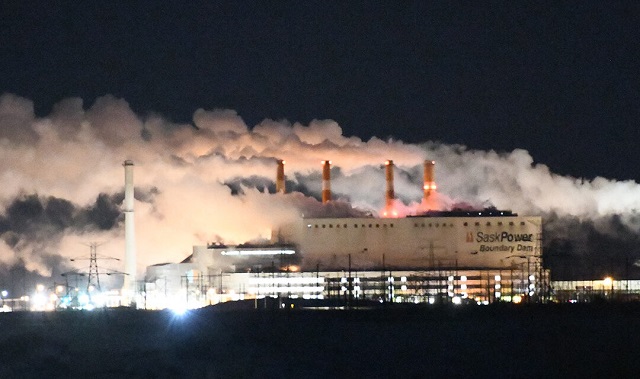Alberta
Alberta’s close brush with blackouts stiffens Moe’s resolve

From the Frontier Centre for Public Policy
“We will not risk plunging our homes, schools, hospitals, special care homes and our businesses into the cold and darkness because of the ideological whims of others.”
Alberta’s close brush with possible rolling blackouts stiffens Moe’s resolve to keep the lights on.
Moe reiterates: “We will not attempt the impossible when it comes to power production”
The past weekend proved to be a close-run thing for the Alberta electrical grid, and Saskatchewan Premier Scott Moe is making statements resolving he won’t allow that to happen here.
Specifically, after having nearly completely divested itself of coal-fired power production, Alberta’s dramatic buildout of wind and solar proved impossible to keep the lights on in that province when the chips were down and temperatures hit -35 C, or worse.
“In Saskatchewan, we will not attempt the impossible when it comes to power production in our province,” Moe said in a post on X and other social media the evening of Monday, Jan. 15.
“We will not risk plunging our homes, schools, hospitals, special care homes and our businesses into the cold and darkness because of the ideological whims of others.
“To support the ongoing power demands across western Canada, Boundary Dam 4 has been restarted to ensure families can continue to keep the heat on. Net zero by 2035 is not only impossible, it’s irresponsible as it would leave Saskatchewan and Western Canadian families freezing and in the dark.”
It was in response to the extraordinary events that occurred in Alberta over the weekend, in which Saskatchewan played a key part. And it was also a tacit acknowledgement that as much as SaskPower’s been trying to wean itself off coal, it just can’t do it yet. We still need it to keep the lights on.
The Alberta Electric System Operator (AESO) declared four “grid alerts,” over four days in a row, starting the afternoon of Friday, Jan. 12. Desperately cold temperatures drove up demand for power, just as the same temperatures reduced wind power generation to nothing at times, and close to nothing for most of the weekend. And since the mass of cold air stretched from the Yukon to Texas, every grid operator in between was in the same boat – high demand but short supply. The Southwest Power Pool, which incorporates parts of 14 states from south of Saskatchewan to the Texas Panhandle, as well as Texas grid operator ERCOT, all put out various forms of alerts suggesting their clients reduce electrical consumption.
Staring into the abyss
The first three of Alberta’s grid alerts ran from mid-afternoon until late evening, but the fourth occurred for an hour on Monday morning, as the workweek began.
The second of those grid alerts turned out to be the most significant. On Saturday, Jan. 13, Alberta came within a half-hour of rotating blackouts, an Alberta Electric System Operator spokesperson told CBC News on Jan. 15, confirmed by Alberta Affordability and Utilities Minister Nathan Neudorf the same day.
Indeed, the province stood at the brink of the abyss Saturday night, as rotating blackouts would have impacted different areas of the province for 20 to 30 minutes at a time, as temperatures ranged from -30 to -45 C, depending on where you were in the province. As the province’s grid-scale batteries neared depletion, and there was nothing left to call upon, the AESO and provincial government put out an emergency alert to all cellphones and TV screens, asking Albertans to shut off and unplug everything they could, from electric vehicle chargers to ovens to bathroom fans.
SaskPower ups its game
Alberta had run out of reserves, and with British Columbia unable to provide much more in the way of additional power, and Montana unable provide much at all, Saskatchewan’s Crown utility SaskPower responded, by sending 153 megawatts westward.
And that, in itself, was extraordinary, because limits were pushed to provide Alberta with as much as possible on the intertie between the two provinces.
SaskPower spokesperson Joel Cherry told Pipeline Online by email, “One hundred fifty-three megawatts is the interconnection’s maximum capacity, but it has been derated to 90 megawatts for the past several months because of ongoing work at a interconnection station at the border. AESO and SaskPower Grid Control have agreed to temporarily increase the transmission capacity to make the extra 63 MW available to Alberta when they declare energy alerts.
Contingency reserve had run out
Generally speaking, power needs to be consumed at the instant its produced. There is very little in the way of grid-scale storage in the Canadian electrical grid, although Alberta has built 10 grid-scale batteries totaling 190 megawatts capacity. All of that capacity would come into play Saturday evening.
Grid operators must maintain a small amount of excess capacity at all times, known as a “dispatched contingency reserve” (DCR) The North American Electric Reliability Corporation (NERC) standard is to maintain at least 4 per cent DCR. That’s because if the DCR runs out, all sorts of bad things happen, with voltage drops and frequency variance which then can lead to cascading brownouts, including additional power generating units tripping off and whole areas going without power.
With demand hovering around 11,800 megawatts, four per cent would have been around 472 megawatts DRC. Instead, for the better part of an hour, the DCR was 20 megawatts, or 0.1 per cent, a razor thin margin. The extra 63 megawatts SaskPower sent in part meant the difference between rotating blackouts or not.
In a very real way, it was payback for Alberta’s weeks-long help for SaskPower during the outage of the Poplar River Power Station at Coronach, Saskatchewan. For weeks on end, Alberta supplied Saskatchewan with around 150 megawatts for parts of the day to keep the lights on in this province.
BC played critical role, too
On any given day, imports and exports of power between Alberta and British Columbia will often run up to 600 megawatts going either direction. But with BC also in the deep freeze, it didn’t have much to give at various points during the weekend, including parts of the crucial Saturday evening. Indeed, around the time the grid alert was first sounded on Saturday, Alberta was still exporting 38 megawatts to British Columbia, according to X bot account @ReliableAB, which posts hourly data from the AESO on the status of the Alberta grid.
For a few hours, BC Hydro was able to ramp up its exports to Alberta during the crucial time. At 5:39, they were exporting 251 megawatts to Alberta, nearly 100 megawatts more than Saskatchewan. For the next few hours they sent around 200 megawatts, but it was not enough, and the AESO sent out its alert.
Additionally, during the third grid alert on Sunday, British Columbia ramping up its power exports at a critical time saved the day, as the Alberta Dispatched Contingency Reserve had briefly hit zero. BC bumped its exports up to 496 megawatts while Saskatchewan contributed 153 and Montana nine. Those increased megawatts from British Columbia appeared to make all the difference on that day.
The cat came back, and so did Unit 4
While all of this was going on, SaskPower spent the weekend getting its coal fired power station Boundary Dam Unit 4 back into play. It’s been on cold standby for months. Officially, by federal regulations it was supposed to retire Dec. 31, 2021, but SaskPower has been forced to bring it back into service multiple times to fill a need, such as when Poplar River went offline last June. It was 139 megawatts that could have been used, but SaskPower has shown reluctance to bring it back into the game, as it were.
And that’s what Moe alluded to in his social media post, saying, “We will not risk plunging our homes, schools, hospitals, special care homes and our businesses into the cold and darkness because of the ideological whims of others.”
This was an oblique reference to the push by the federal government to shut down coal and natural gas-fired power generation by 2035, according to the proposed Clean Electricity Regulations, using similar words that Moe has expressed before. The federal preference is for more renewables, in particular wind and solar.
Several years ago, the federal government and Saskatchewan reached an equivalency agreement, recognizing the Boundary Dam Unit 3 Carbon Capture and Storage Project and therefore allowing a few more years operation out of other coal units. But to get that agreement, SaskPower had to agree to adding a further 3,000 megawatts of wind and solar by 2035, according to SaskPower president and CEO Rupen Pandya in an interview Sept. 25, 2023.
Pandya said, “When we signed the equivalency agreement with the federal government in 2014 to allow us to keep using coal to the end of 2030, part of that agreement required us to build out renewables in the province, so that we could operate coal assets, coal generators, past their end of life. And that’s what we’ve been able to do. And we continue to do. So, part of the build out of renewables that’s required as part of the equivalency agreement, that 3,000 megawatts that we need to put in place by 2035. I think 2,000 by 2030. A good tranche of that will be in that south central part of Saskatchewan around the Coronach. So we currently have in the market an RFP for 700 megawatts of wind and solar in the Coronach region, so it’ll will actually go into power, if all goes well with RFPs, in 2027.”
On a typical fall day, SaskPower’s total power demand hovers around 3,000 megawatts. On a cold winter day, it’s closer to 3,500 megawatts. But that’s before widespread adoption of electric vehicles, which the federal government is also trying to force upon Canadians.
Saskatchewan held up to the cold
SaskPower’s Joel Cherry told Pipeline Online on Jan. 15, “Saskatchewan’s system has held up during the extreme cold. We had no major issues.”
However, “Poplar River Power Station was operating at reduced capacity earlier in the weekend because of issues with coal supply. As of yesterday (Sunday) we are back to normal operations there.”
That means the reduced capacity occurred the same day Alberta was stretched nearly to the breaking point.
Asked if we lost a major unit, while Alberta was at the same time in crisis, what did we have for backup? Was there additional capacity available from Manitoba and/or Southwest Power Pool?” Cherry replied, “SaskPower has maintained adequate reserves to allow for the continued stability of the system even if we lost a large unit. We have also been importing from Manitoba and the SPP when available.
Collapse of wind
Major factors in Alberta’s power woes were the utter collapse of wind and solar power generation. Even at its best, solar power production during the day was around a third of maximum capacity.
Wind turbines started shutting down Thursday night as temperatures plummeted below -30 C, the temperature where cold brittle behaviour of materials risks catastrophic failure of the turbines. The three evening grid alerts all came on as the sun went down and the roughly 500 megawatts (of 1,650 megawatts capacity) faded with the setting sun. On Friday, Alberta’s wind generation fell to 6 megawatts at one point. It was minimal on Saturday. On Sunday morning, multiple times wind hit zero – not one megawatt from the 4,481 megawatts of wind generation capacity.
SaskPower’s Where Your Power Comes From webpage noted on Friday, Jan. 14, Saskatchewan’s 617 megawatts of grid-scale wind produced a 24-hour average of 21 megawatts. On Saturday, that number was 19. On Sunday, the average was 22 megawatts. Unlike the previous week, where there were seven days where wind in Saskatchewan hit zero power output, Jan. 12-14 did not have any periods of zero.
“We had four hours of less than 10 megawatts wind output on Jan 12, despite the low average through the day on Jan. 13 we only had a half hour below 10 megawatts and on Jan 14 we had 7.8 hours below 10 megawatts,” Cherry said.
Ten megawatts is 1.6 per cent of total grid-scale wind capacity in Saskatchewan.
As for Unit 4, in April of 2023, Pipeline Online reported Cherry said at the time, “We’re going to keep BD 4 in laid up status until Great Plains Power Station comes online, or until March 31, 2024.”
The most recent plan, as of April, 2023, was to shut down, for good, Unit 4 by March 31, 2023. Whether Moe’s statement on Jan. 15 will extend that is unknown at the time of writing.
Brian Zinchuk is editor and owner of Pipeline Online, and occasional contributor to the Frontier Centre for Public Policy. He can be reached at [email protected]. For further information read the original publication here.
Alberta
Alberta judge sides with LGBT activists, allows ‘gender transitions’ for kids to continue

From LifeSiteNews
‘I think the court was in error,’ Alberta Premier Danielle Smith has said. ‘There will be irreparable harm to children who get sterilized.’
LGBT activists have won an injunction that prevents the Alberta government from restricting “gender transitions” for children.
On June 27, Alberta King’s Court Justice Allison Kuntz granted a temporary injunction against legislation that prohibited minors under the age of 16 from undergoing irreversible sex-change surgeries or taking puberty blockers.
“The evidence shows that singling out health care for gender diverse youth and making it subject to government control will cause irreparable harm to gender diverse youth by reinforcing the discrimination and prejudice that they are already subjected to,” Kuntz claimed in her judgment.
Kuntz further said that the legislation poses serious Charter issues which need to be worked through in court before the legislation could be enforced. Court dates for the arguments have yet to be set.
READ: Support for traditional family values surges in Alberta
Alberta’s new legislation, which was passed in December, amends the Health Act to “prohibit regulated health professionals from performing sex reassignment surgeries on minors.”
The legislation would also ban the “use of puberty blockers and hormone therapies for the treatment of gender dysphoria or gender incongruence” to kids 15 years of age and under “except for those who have already commenced treatment and would allow for minors aged 16 and 17 to choose to commence puberty blockers and hormone therapies for gender reassignment and affirmation purposes with parental, physician and psychologist approval.”
Just days after the legislation was passed, an LGBT activist group called Egale Canada, along with many other LGBT organizations, filed an injunction to block the bill.
In her ruling, Kuntz argued that Alberta’s legislation “will signal that there is something wrong with or suspect about having a gender identity that is different than the sex you were assigned at birth.”
She further claimed that preventing minors from making life-altering decisions could inflict emotional damage.
However, the province of Alberta argued that these damages are speculative and the process of gender-transitioning children is not supported by scientific evidence.
“I think the court was in error,” Alberta Premier Danielle Smith said on her Saturday radio show. “That’s part of the reason why we’re taking it to court. The court had said there will be irreparable harm if the law goes ahead. I feel the reverse. I feel there will be irreparable harm to children who get sterilized at the age of 10 years old – and so we want those kids to have their day in court.”
READ: Canadian doctors claim ‘Charter right’ to mutilate gender-confused children in Alberta
Overwhelming evidence shows that persons who undergo so-called “gender transitioning” procedures are more likely to commit suicide than those who are not given such irreversible surgeries. In addition to catering to a false reality that one’s sex can be changed, trans surgeries and drugs have been linked to permanent physical and psychological damage, including cardiovascular diseases, loss of bone density, cancer, strokes and blood clots, and infertility.
Meanwhile, a recent study on the side effects of “sex change” surgeries discovered that 81 percent of those who have undergone them in the past five years reported experiencing pain simply from normal movements in the weeks and months that followed, among many other negative side effects.
Alberta
Alberta Independence Seekers Take First Step: Citizen Initiative Application Approved, Notice of Initiative Petition Issued

Alberta’s Chief Electoral Officer, Gordon McClure, has issued a Notice of Initiative Petition.
This confirms a Citizen Initiative application has been received and the Chief Electoral Officer has determined the requirements of section 2(3) of the Citizen Initiative Act have been met.
Approved Initiative Petition Information
The approved citizen initiative application is for a policy proposal with the following proposed question:
Do you agree that Alberta should remain in Canada?
The Notice of Initiative Petition, application, and statement provided by the proponent are available on Elections Alberta’s website on the Current Initiatives Petition page.
As the application was received and approved prior to coming into force of Bill 54: Election Statutes Amendment Act, the Citizen Initiative process will follow requirements set out in the Citizen Initiative Act as of June 30, 2025.
Next Steps
- The proponent must appoint a chief financial officer within 30 days (by July 30, 2025).
- Once the 30-day publication period is complete and a chief financial officer has been appointed, Elections Alberta will:
- issue the citizen initiative petition,
- publish a notice on the Current Initiatives Petition page of our website indicating the petition has been issued, specifying the signing period dates, and the number of signatures required for a successful petition, and
- issue the citizen initiative petition signature sheets and witness affidavits. Signatures collected on other forms will not be accepted.
More information on the process, the status of the citizen initiative petition, financing rules, third party advertising rules, and frequently asked questions may be found on the Elections Alberta website.
Elections Alberta is an independent, non-partisan office of the Legislative Assembly of Alberta responsible for administering provincial elections, by-elections, and referendums.
-

 Alberta1 day ago
Alberta1 day agoAlberta judge sides with LGBT activists, allows ‘gender transitions’ for kids to continue
-

 Business1 day ago
Business1 day agoCanada Caves: Carney ditches digital services tax after criticism from Trump
-

 Crime1 day ago
Crime1 day agoSuspected ambush leaves two firefighters dead in Idaho
-

 Alberta1 day ago
Alberta1 day agoAlberta Independence Seekers Take First Step: Citizen Initiative Application Approved, Notice of Initiative Petition Issued
-

 Crime14 hours ago
Crime14 hours agoNational Health Care Fraud Takedown Results in 324 Defendants Charged in Connection with Over $14.6 Billion in Alleged Fraud
-

 Health14 hours ago
Health14 hours agoRFK Jr. Unloads Disturbing Vaccine Secrets on Tucker—And Surprises Everyone on Trump
-

 Business3 hours ago
Business3 hours agoElon Musk slams Trump’s ‘Big Beautiful Bill,’ calls for new political party
-

 Business1 day ago
Business1 day agoMassive government child-care plan wreaking havoc across Ontario






